House Monpezat Name Henrik, Consort | Mother Renee Yvonne Doursenot | |
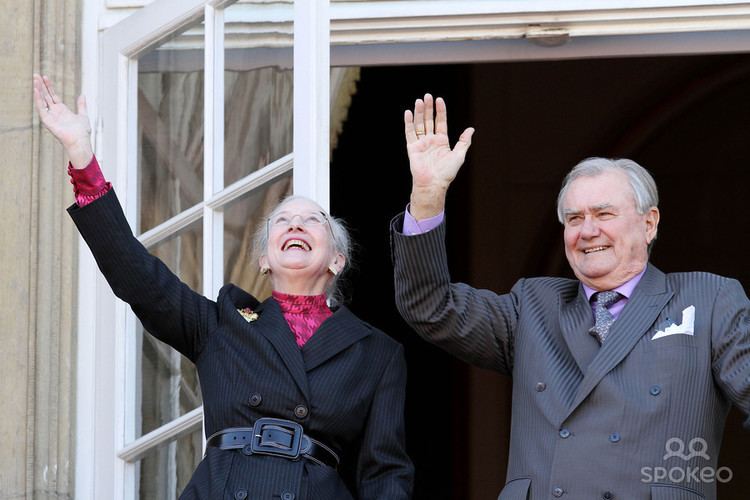 | ||
Tenure 14 January 1972 – present Born 11 June 1934 (age 91)
Talence, Gironde, France ( 1934-06-11 ) Issue Frederik, Crown Prince of Denmark
Prince Joachim Father Andre de Laborde de Monpezat Religion Church of Denmark
prev. Roman Catholic Spouse Margrethe II of Denmark (m. 1967) Children Frederik, Crown Prince of Denmark, Prince Joachim of Denmark Grandchildren Prince Nikolai of Denmark Parents Renee Doursenot, Count Andre de Laborde de Monpezat Books Cantabile, Ikke Altid Gaselever (not always foie gras), Frihjul, Murmures de vent Similar People Margrethe II of Denmark, Prince Joachim of Denmark, Frederik - Crown Prince of, Princess Marie of Denmark, Mary - Crown Princess | ||
Meet the Danish Royals:Henrik,Prince Consort of Denmark
Henrik, Prince Consort of Denmark ([ˈhenˀʁaeɡ̊]; born Henri Marie Jean Andre de Laborde de Monpezat 11 June 1934), is the husband of Queen Margrethe II. Henrik married Margrethe, then heiress presumptive to the Danish throne, at the Naval Church of Copenhagen on 10 June 1967. The couple have two sons, Crown Prince Frederik (born 1968) and Prince Joachim (born 1969). Henrik became Prince Consort of Denmark when his wife (Queen Margrethe II) acceded to the throne of her father, King Frederick IX, on 14 January 1972. In her New Year's speech to the Danish people on 31 December 2015 Queen Margrethe announced that Prince Henrik would 'wind down' and give up most of his official duties with immediate effect from 1 January 2016.
Contents
- Meet the Danish RoyalsHenrikPrince Consort of Denmark
- Early life
- Marriage
- 2002 flight from Denmark
- Poetry
- Titles and styles
- French title controversy
- Royal spouses and titles
- Honours and awards
- Danish honours
- Greenlandic honours
- French honours
- Foreign honours
- Publications
- References
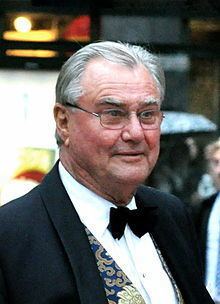
Early life
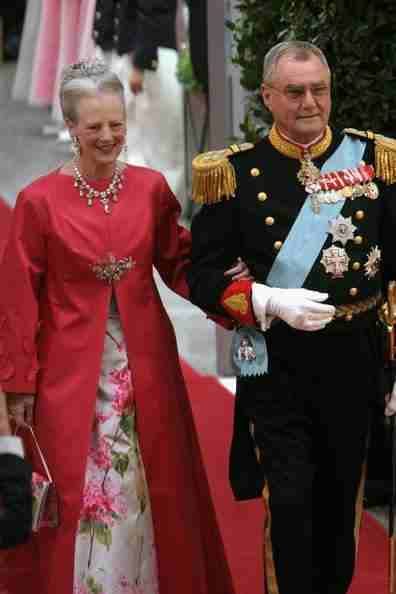
Henrik was born in Talence, Gironde, France. He was the son of Andre de Laborde de Monpezat (Mont-de-Marsan, 6 May 1907 – Le Cayrou, 23 February 1998) and his wife, Renee Doursenot (Perigueux, 26 October 1908 – Le Cayrou, 11 February 2001) (married religiously in Cahors, 6 January 1934 and civilly in Cahors, 22 January 1948), who was previously married firstly civilly in Paris on 29 September 1928 and divorced at the Tribunal Civil Francais de Saigon on 21 September 1940 Louis Leuret (Chateauneuf-sur-Loire, 18 March 1881 – Saigon, South Vietnam, 29 December 1962). He was raised Catholic.
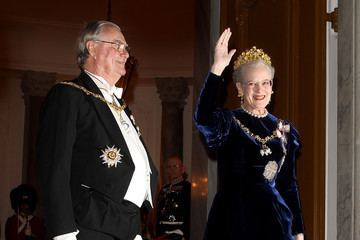
He spent his first five years in Hanoi (Vietnam), where his father looked after family business interests. He returned to Hanoi in 1950, graduating from the French secondary school there in 1952. Between 1952 and 1957 he simultaneously studied law and political science at the Sorbonne, Paris, and Chinese and Vietnamese at the Ecole Nationale des Langues Orientales (now known as INALCO). He also studied in Hong Kong in 1957 and Saigon in 1958.
After military service with the French Army in the Algerian War between 1959 and 1962, he joined the French Foreign Affairs ministry in 1962, working as a Secretary at the embassy in London from 1963 to 1967.
Marriage
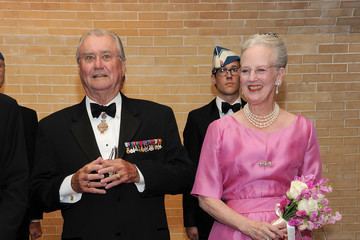
On 10 June 1967 he married Princess Margrethe, the heiress presumptive to the Danish throne, at the Naval Church of Copenhagen. At the time of the wedding his name was Danicised to Henrik and he was created HRH Prince Henrik of Denmark. Before the wedding, the Prince converted to Protestantism.
The Queen and The Prince Consort have two children and eight grandchildren:
Prince Henrik's native language is French, and his second language is Danish. Although he quickly learned Danish after marrying Margrethe, Danes still joke about his grasp of Danish and his thick French accent. He also speaks fluent English, Chinese and Vietnamese.
2002 "flight" from Denmark
In 2002, Henrik left Denmark and went to stay at the couple's Chateau de Caix in Cahors in southern France. The reason for Henrik's departure from Denmark was due to a New Year's Day reception in which his son, Crown Prince Frederik, was appointed host in the absence of Queen Margrethe. Henrik felt "pushed aside, degraded and humiliated" at the fact that he was relegated to "third place in the royal hierarchy."
"For many years I have been Denmark's number two," he said. "I've been satisfied with that role, but I don't want to be relegated to number three after so many years." Henrik "fled" Denmark to reflect on his status in the Danish Royal Family. Queen Margrethe flew to France to meet with her husband. Henrik stressed that neither his wife nor son were to blame for the incident. The Prince Consort spent three weeks in Caix, and did not appear with his wife as expected at the wedding of Willem-Alexander, Prince of Orange, and Maxima Zorreguieta. After three weeks, Henrik returned to Denmark and resumed his royal duties.
On 30 April 2008, shortly before the wedding of his younger son, Prince Joachim, to Marie Cavallier, the title "Count of Monpezat" (Danish: Greve af Monpezat) was conferred by the Queen on both of her sons, and made hereditary for their male-line descendants, both male and female. The Queen's Private Secretary Henning Fode commented, "The Queen and the Prince Consort have considered this for quite some time, and it has led to the belief that it was the right thing to do."
In fact, Henrik had mentioned this possibility as long ago as 1996, in his published memoir, "During our generation the future sovereign will perhaps receive approval to see 'Monpezat' added to the dynastic name of 'Oldenburg-Glucksburg'". While being interviewed by the French weekly Point de Vue in October 2005, Henrik raised the issue shortly after the birth of Crown Prince Frederik's first son, Prince Christian, who is expected to inherit the Danish crown one day: "It also makes him very proud and happy that Monpezat will be added to this small grandson's future name as Prince of Denmark. 'It is a great joy for me that his French roots will also be remembered.'" Although no announcement was made at that time, Prince Christian does now include (part of) his French grandfather's surname among his hereditary titles. The grant does not extend this Danish comital title to Henrik himself.
Poetry
Henrik has written many poems in his native language French, some of which have been published in the poetry collections; Chemin faisant (1982), Cantabile (2000), Les escargots de Marie Lanceline (2003), Murmures de vent (2005), Frihjul (Roue-Libre, 2010), Fabula (2011), La part des anges (2013), and Dans mes nuits sereines (2014). The symphonic suite Cantabile by Frederik Magle is based on Henrik's poetry collection Cantabile and was premiered by the Danish National Symphony Orchestra at two concerts celebrating Henrik's 70th and 75th birthdays in 2004 and 2009.
Henrik has said about writing poetry (translated from Danish): "I see poetry as an opportunity for immersion in a superficial time dominated by news and entertainment that makes us rootless and restless. Poetry takes us closer to the true nature of the world, in poetry we can approach the eternal questions such as love, loneliness and death."
Titles and styles
* Use is disputed, see section "French title controversy" below
French title controversy
The Laborde de Monpezat family style themselves as counts, though their right to the use of that title is disputed: The Encyclopedie de la fausse noblesse et de la noblesse d'apparence (English: Encyclopedia of False and Seeming Nobility) states that Prince Henrik's ancestor, Jean Laborde, received royal letters patent of ennoblement in 1655, conditional on his reception as a noble in the Estates of the province of Bearn where his lands were located. But this condition was never fulfilled, as the Estates refused Laborde's petitions in 1703 and again in 1707. The family's surname was "Monpezat" by the time of the French Revolution, without title, until 14 July 1860, when it was changed by imperial decree to "de Laborde-Monpezat", and legally changed again on 19 May 1861 to "de Laborde de Monpezat". Although the comital title has been used by the family as if it were a titre de courtoisie, traditionally the royal court and French society accepted such titles when used by genuinely noble families. Since the title was assumed by Henrik's ancestor prior to the twentieth century, it is possible he was unaware of the misuse until his family's history was scrutinized by genealogists after his engagement. Henrik's 1996 autobiography acknowledges the unsuccessful ennoblement.
Royal spouses and titles
Danish law never required that royal spouses be of aristocratic origin. Nonetheless, no prince's marriage to a woman who lacked male-line descent from royalty or titled nobility had been accepted as dynastic by the sovereign in the course of Denmark's history as a hereditary monarchy, prior to the marriage of the heir to the throne, Princess Margrethe, in June 1967. Moreover, six months later Margrethe's first cousin, Prince Ingolf of Denmark, married an untitled commoner and was demoted to a count, and another cousin, Prince Christian of Denmark, also wed a Dane, Anne Dorte Maltoft-Nielsen, in 1971, forfeiting his dynastic position. Christian later commented on the dynasty's marital rules in the Danish periodical, Billed-Bladet:
As protocol dictates, I had to ask my uncle, King Frederick IX, if he had any objections to my getting engaged ... I knew I would have to renounce my title of prince and my right of succession if I married her. I was number four in the line of succession after Princess Margrethe, Princess Benedikte, and my father. My brother, Ingolf, had two years previously lost his princely title and succession right when he married a commoner, Countess Inge. Now I was ready to follow him. To me, it didn't matter if I were in line for the throne or not... My uncle, of course, had nothing against a union between Anne Dorte and me.
Decades later, Henrik's sons Frederik and Joachim both married foreign commoners without any serious doubt being raised about their continued eligibility for the throne.
Honours and awards
See also : List of honours of the Danish Royal Family by country
Danish honours
Greenlandic honours
French honours
Foreign honours
Publications
Prince Henrik has translated several books into Danish, as well as publishing several other books.
